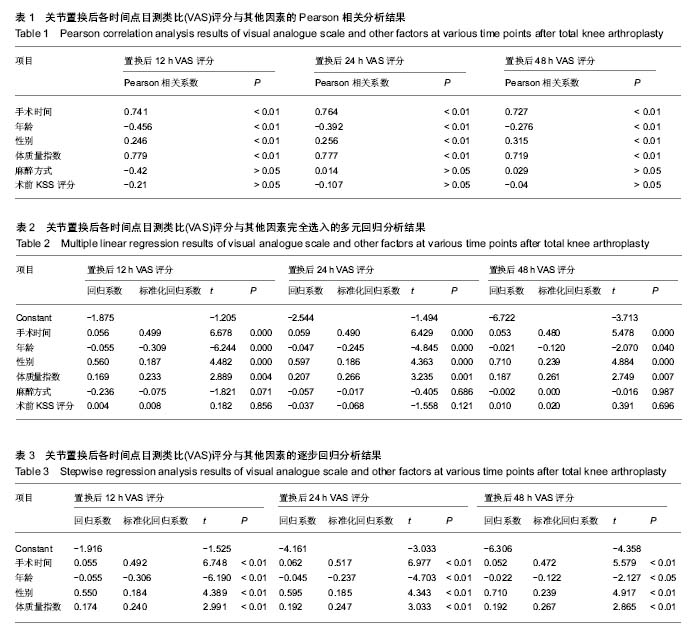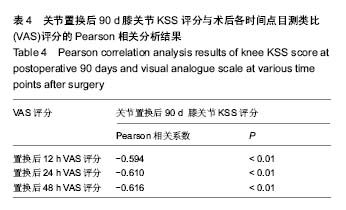中国组织工程研究 ›› 2017, Vol. 21 ›› Issue (7): 993-997.doi: 10.3969/j.issn.2095-4344.2017.07.002
• 人工假体 artificial prosthesis • 上一篇 下一篇
人工膝关节置换术后疼痛影响因素的分析
史 斌,安 静,陈龙刚,张 男,田 野
- 中国医科大学附属盛京医院,辽宁省沈阳市 110004
Influencing factors for pain after total knee arthroplasty
Shi Bin, An Jing, Chen Long-gang, Zhang Nan, Tian Ye
- Shengjing Hospital Affiliated to China Medical University, Shenyang 110004, Liaoning Province, China
摘要:
文章快速阅读:
.jpg) 文题释义:
文题释义:膝关节假体:包括膝关节置换用的带偏心距的胫骨底板组件和相关配件(包括补偿型胫骨底板、胫骨底板转接头、胫骨底板垫片、胫骨锁定接头)。所有组件均采用Ti6Al4V材料和超高分子量聚乙烯制成,钛合金部件表面无着色,非关节面部分表面采用磨砂表面处理。产品一次性使用,经电离辐射灭菌。
回归分析:是确定两种或两种以上变量间相互依赖的定量关系的一种统计分析方法。运用十分广泛,回归分析按照涉及的自变量的多少,分为回归和多重回归分析;按照自变量的多少,可分为一元回归分析和多元回归分析;按照自变量和因变量之间的关系类型,可分为线性回归分析和非线性回归分析。如果在回归分析中,只包括一个自变量和一个因变量,且二者的关系可用一条直线近似表示,这种回归分析称为一元线性回归分析。如果回归分析中包括两个或两个以上的自变量,且因变量和自变量之间是线性关系,则称为多重线性回归分析。
摘要
背景:全膝关节置换后患者疼痛是影响置换后膝关节功能恢复的主要原因。
目的:探索及分析人工膝关节置换术后疼痛相关影响因素。
方法:对160例膝关节骨性关节炎患者行人工膝关节置换,对患者置换后12,24,48 h疼痛情况进行疼痛目测类比(VAS)评分;对患者置换前、置换后90 d的膝关节功能进行KSS评分;应用Pearson相关分析及多重线性回归分析分别对术后各时间点目测类比评分与患者手术时间、年龄、性别、体质量指数、麻醉方式、关节置换前KSS评分等因素进行统计分析;并分析置换后90 d KSS评分与置换后各时间点目测类比评分之间的关系。
结果与结论:①Pearson相关分析及多重线性回归分析结果可以看出手术时间、性别、体质量指数与关节置换后12,24,48 h目测类比评分呈正相关;②年龄与置换后12,24,48 h目测类比评分呈负相关;③关节置换后12,24,48 h目测类比评分与置换后90 d KSS评分呈负相关;④结果表明,患者性别、手术时间长短、体质量指数及患者年龄均为人工膝关节置换术后疼痛影响因素;膝关节置换后疼痛影响置换后功能康复。
中国组织工程研究杂志出版内容重点:人工关节;骨植入物;脊柱;骨折;内固定;数字化骨科;组织工程
ORCID:0000-0002-0433-7554(史斌)
中图分类号:


.jpg) 文题释义:
文题释义: